surges 7 times, dare not chase, can we go long ?
2025-06-24 09:35
Editor's Note: Recently, Circle's strong performance after its IPO has made investors who missed the opportunity feel anxious. Many investors who have been left out are actively seeking alternatives to Circle, with Coinbase being the most popular choice, as it has a close business relationship with USDC, and investors widely believe that market expectations for Circle and USDC can also be priced into Coinbase's stock price.
Artemis, an institutional data platform, stated that many investors recently recommended going long on Coinbase while shorting Circle. However, its fundamental analyst Kevin Li believes that investors should not go long on Coinbase just because they are bullish on Circle, as USDC-related revenue only accounts for a small portion of Coinbase's total revenue. Although Coinbase is a large ecosystem covering compliance exchanges, USDC, on-chain products, etc., its various businesses are currently facing competitive pressures, and the situation is not optimistic. Investors need to be cautious when pricing it.
Odaily Planet Daily translated Kevin Li's comprehensive fundamental analysis of Coinbase below. Enjoy~
Summary:
Limited Upside Potential in Stablecoin Revenue: Circle's IPO highlighted the prospects of stablecoins, but Coinbase only holds a small share in the USDC market. According to the revenue-sharing agreement, Coinbase can receive approximately 60% of the total USDC revenue, but it retains only a small portion, as about 43% will be distributed to users. Therefore, Coinbase actually only earns 34% of the total stablecoin revenue.
Regulatory Moat Gradually Fading: Coinbase has always benefited from the uncertainty of crypto regulation, using its high compliance infrastructure costs as a competitive moat. However, as regulation becomes more friendly and transparent, competitors gain more vitality, and Coinbase's advantage will gradually weaken.
Exchange Business Under Pressure: Coinbase's transaction fees have dropped from 2.5% to 1.4%, and its market share has fallen from over 58% to around 38%. This is mainly due to fee compression and increasing competition from ETFs, decentralized exchanges (DEXs), and TradFi platforms like Robinhood. Coinbase is expanding subscription services (Coinbase One), staking, USDC interest income, and derivative products to offset the impact of weak spot trading volume. The proportion of transaction revenue in total revenue has decreased from over 90% in the previous cycle to around 55% in this cycle.
Base is Gaining Momentum: Coinbase's Ethereum Layer 2 platform Base is showing rapid growth in both transaction volume and profitability. It currently leads all Ethereum Layer 2s in transaction volume and active addresses, but still lags behind Solana in overall user activity and adoption momentum.
Derivatives are Gaining Momentum: Coinbase derivatives trading volume has surged to over $300 billion per month, but its monetization and long-term growth are still constrained by aggressive liquidity incentives and fierce competition from ETF-type cryptocurrency options.
Valuation Seems Attractive: Comprehensive analysis shows that Coinbase's valuation is approximately $108.592 billion, but the market has correctly reflected its structural risks in terms of exchange moat and long-term profit margins.
Coinbase's Path to Becoming a Major Ecosystem Player
To understand the challenges Coinbase is currently facing and why it cannot fully replace Circle, we need to look back at its origins. Coinbase initially started as a cryptocurrency exchange, emerging in an era when it was difficult for ordinary users to purchase Bitcoin. With its intuitive and easy-to-use features, Coinbase quickly gained widespread adoption, and its proactive compliance initiatives in the early stages brought significant advantages, allowing it to expand its business in both retail and institutional markets.
Built on trust, convenience, and legal clarity, Coinbase quickly stood out among exchanges and gained a loyal user base. Thus, Coinbase shifted its focus to exploring other profit opportunities. It launched advanced subscription services like Coinbase One and introduced staking products, allowing users to earn income through their assets.
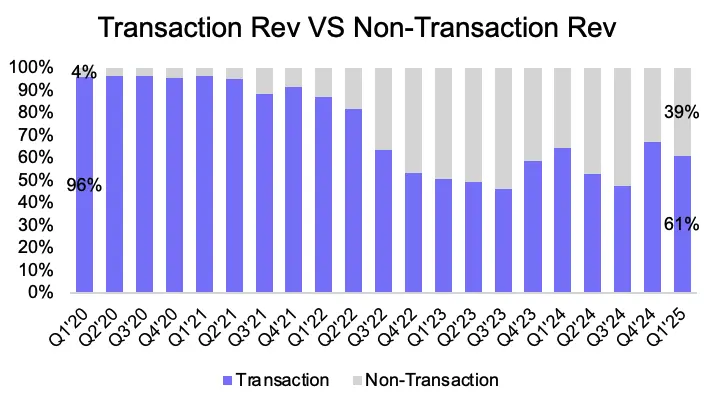
The percentage of Coinbase transaction revenue in total revenue has declined over time. Source: Coinbase Quarterly Reports, Artemis
As Coinbase's brand and influence expanded, Coinbase and Circle jointly launched USDC - a compliant stablecoin intended to replace USDT and BUSD. The integration and reputation of Coinbase's platform accelerated the adoption of USDC, and the interest rate for USDC on Coinbase reached around 5%. The interest earned from USDC reserves further increased Coinbase's revenue.
To complete its ecosystem, Coinbase launched Ethereum Layer 2 - Base in 2024. With this chain, Coinbase now controls a full-stack infrastructure: exchanges, stablecoins, and blockchain, forming a vertically integrated crypto ecosystem.
The exchange business and the brand it built have always been the engine behind Coinbase's vast ecosystem. Subsequent products are not just new features, but also ways to convert existing core users and the trust established on the exchange into profitable avenues.
The core of Coinbase's business model follows a simple equation:
Revenue = Number of Users × ARPU (Average Revenue Per User)
Its strategy has always focused on expanding both ends of this equation: expanding the user base through strong distribution channels and good regulatory reputation, and increasing ARPU by introducing new, value-added on-chain products within its ecosystem. Therefore, its business core is to acquire users through exchanges and improve profitability through a layered product stack.
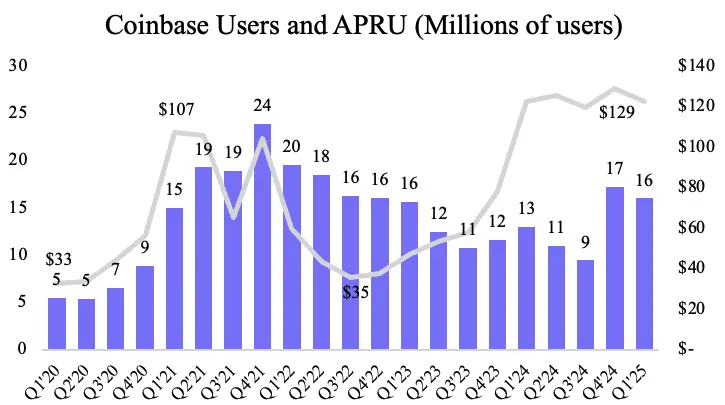
Coinbase's user growth remains relatively stable, and ARPU (driven by commission rates + product line increases) has grown over time. Source: Coinbase Quarterly Reports, Artemis, Data Ai
Coinbase Is Not a Pure Agent of Circle or USDC
Although Coinbase's ecosystem strategy is attractive, it also makes the investment logic complex. Coinbase's business scope is broad, which means it cannot be seen as a pure agent of USDC or Circle.Currently, revenue related to USDC accounts for only 15% of Coinbase's total revenue, far less than its exchange business transaction fees.However, due to increasing competition from ETFs, decentralized exchanges (DEXs), and TradFi platforms like Robinhood, this core revenue source is facing growing pressure.
Therefore, buying Coinbase as a substitute for being bullish on Circle or USDC is not a wise investment choice.In response to the competitive traditional business, Coinbase is trying to build a broader and more enduring business model to diversify its operations and free itself from the constraints of the trading business. Currently, Coinbase's business mainly covers four major segments:
Cryptocurrency Exchange Business: This is Coinbase's core business, with revenue mainly coming from transaction fees.
Subscription and Blockchain Rewards: Including products such as Coinbase One and additional services for exchange business like institutional staking and custody.
USDC and Interest Income: This revenue source includes interest income from USDC reserves and interest income from cash held on Coinbase's balance sheet.
Base: Transaction fee income from the Ethereum Layer 2 chain.
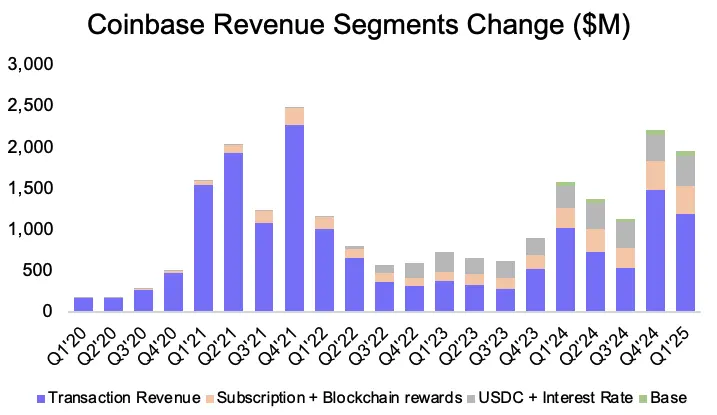
Coinbase revenue segment breakdown over time, with new business lines contributing increasingly. Source: Coinbase Quarterly Reports, Artemis
Revival of USDC: Transaction Volume Growth, But Advantages Are Weakening
For investors who are interested in Circle's IPO, the reason to be bullish on Coinbase is concentrated in its stablecoin business. USDC adoption is growing: among 30 million active stablecoin addresses, over 8 million use USDC, with weekly transaction volumes exceeding 300 million, and this upward trend shows no sign of slowing down.
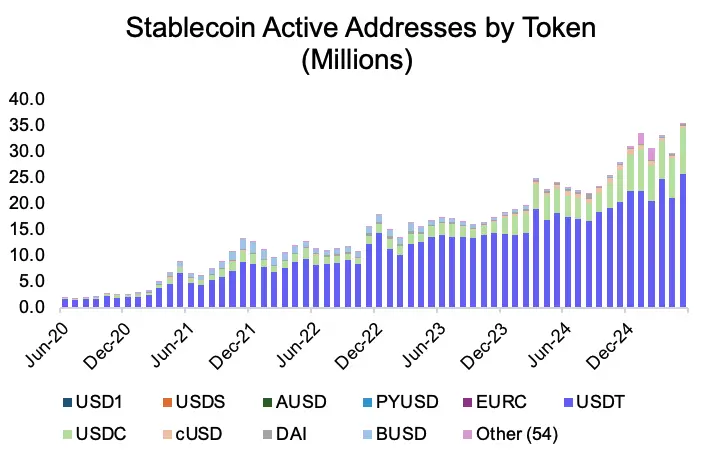
Active stablecoin addresses by token. Source: Artemis
Coinbase earns revenue from U.S. Treasury bonds supporting USDC and shares it with Circle. As the market capitalization of USDC continues to rise, Coinbase's stablecoin-related revenue has grown to approximately $1 billion annually, accounting for about 20% of Coinbase's total revenue.
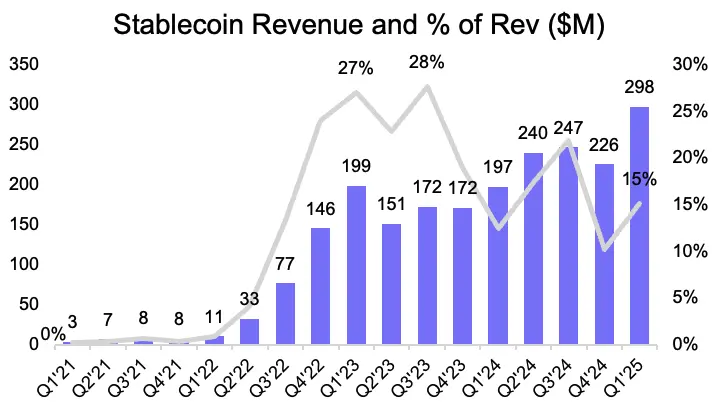
Coinbase's stablecoin revenue and revenue share. Source: Coinbase Quarterly Reports, Artemis
However, this figure masks the actual profits retained by Coinbase, as about half of the stablecoin-related revenue is returned to users in the form of staking rewards. Coinbase uses this as a marketing strategy to retain users, but as competitors like Robinhood also start offering users fund returns, Coinbase's appeal will diminish. Therefore, Coinbase's actual net stablecoin revenue is close to $171 million per quarter.
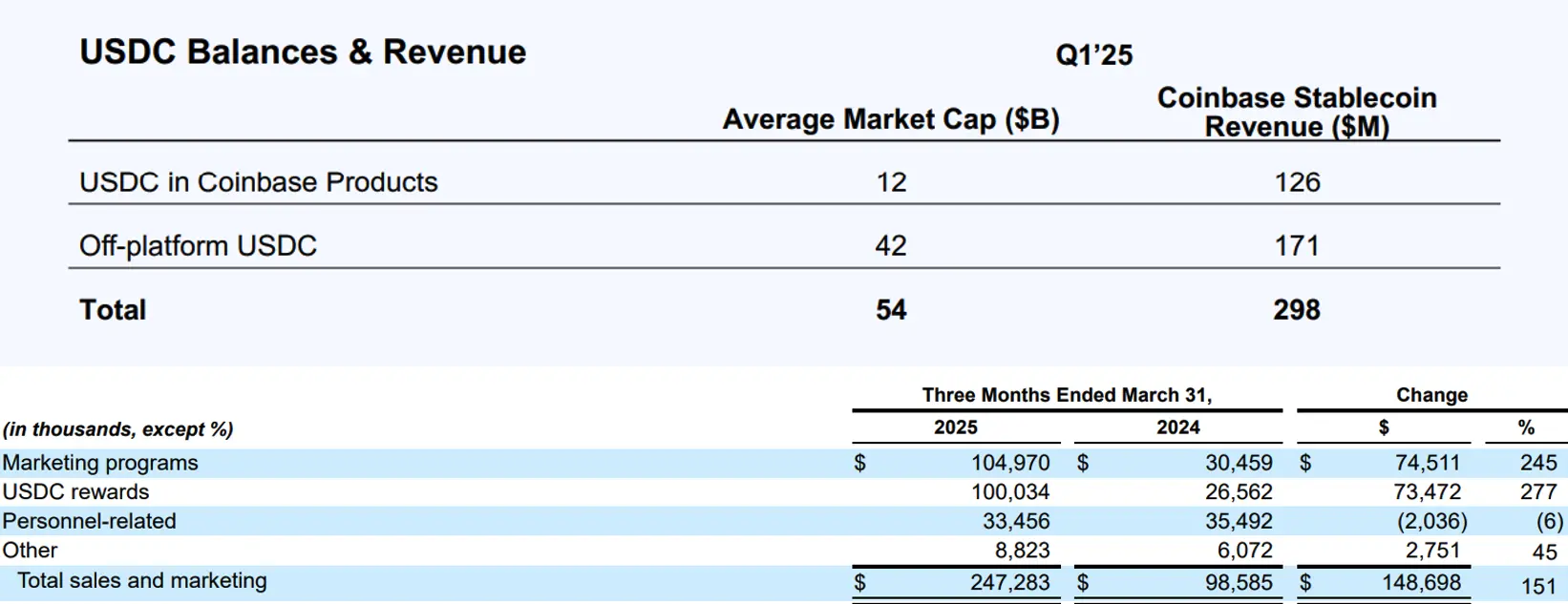
Coinbase stablecoin revenue allocation and Coinbase marketing cost structure. Source: Coinbase Q1 2025 Report
In addition, USDC has long positioned itself as a regulated stablecoin closely related to the U.S. dollar ecosystem. Many believe that the U.S. may take regulatory actions against USDT similar to those taken against BUSD, which would be an asymmetric benefit for USDC. Although there is expected regulatory pressure on USDT, it still dominates the stablecoin market, accounting for about 75% of U.S. dollar stablecoin transactions.
USDC's recovery after the Silicon Valley Bank collapse has been slow, and its adoption has been poor in regions such as Canada, Bermuda, and Puerto Rico. Meanwhile, Cantor Fitzgerald holds a 5% stake in Tether(Odaily Note: Cantor Fitzgerald is a large comprehensive financial services company, one of the 24 "primary dealers" authorized by the Federal Reserve Bank, directly participating in the issuance and trading of U.S. Treasuries), and under the leadership of Howard Lutnick, it manages assets of $134 billion, indicating that the regulatory risk for USDT is also decreasing, and the compliance advantage of USDC is being eroded.
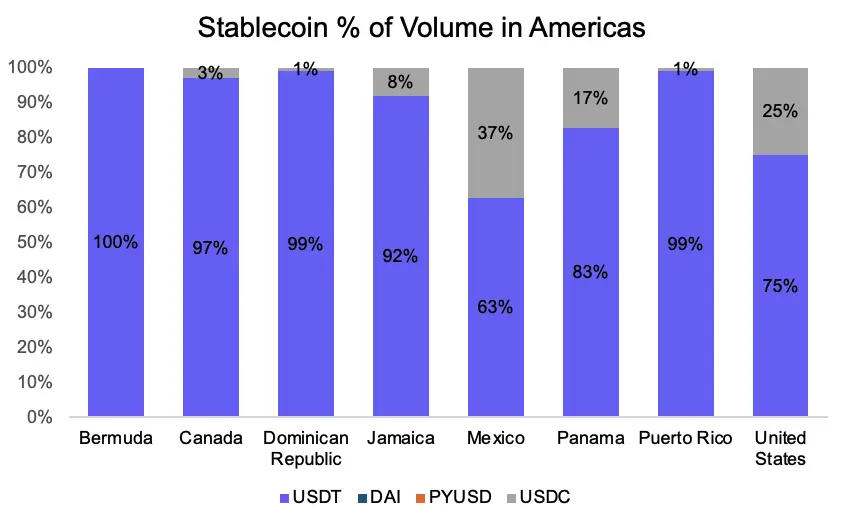
USDC vs. USDT stablecoin transaction volume in the Americas. Source: Artemis
In summary, Coinbase shares economic interests with Circle, but it only gains a small portion of the USDC price increase. In the stablecoin market, Tether still dominates, and the potential market share growth of USDC remains limited, which also limits Coinbase's risk exposure. Although Circle's stock has shown a parabolic rise, this largely reflects its future growth expectations in the payments sector.
Since Coinbase's contribution to USDC growth mainly comes from its platform promotion, its driving role in the next phase of USDC's rise is limited. If you are bullish on Circle, investing directly in Circle would be better than investing in Coinbase.
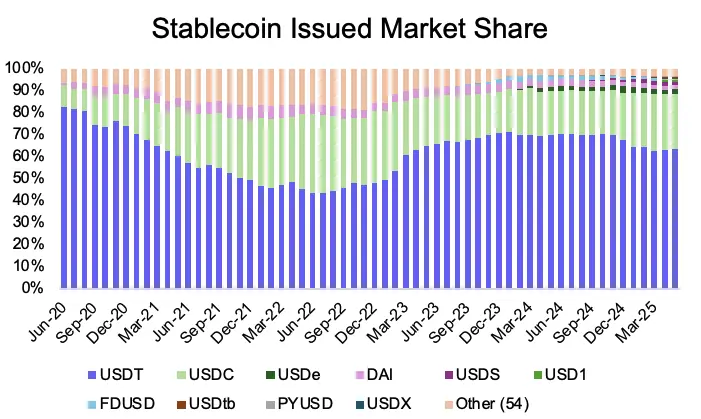
Stablecoin market share. Source: Artemis
Next, we will explore the growing pressures faced by Coinbase's other business lines (including its core exchange and on-chain infrastructure) to analyze why investing in Coinbase now requires caution.
Coinbase Exchange Business: ETFs, DEX Competition Intensifies, and Coinbase's Moat is Eroded
Exchange business is driven by the supply side, meaning users choose exchanges that list the assets they need. When compliance is no longer an issue, competitiveness depends more on which exchange can provide the latest hype or high-return tokens, rather than brand loyalty. New or hot tokens (especially speculative or Meme coins) often trigger a surge in user activity, and listing hot assets can significantly boost an exchange's trading volume and active users.
There are usually three types of tokens in the market:
Blue-chip assets: High liquidity, trustworthy, and usually considered "safe" (e.g., BTC, ETH, SOL).
VC Coins: Supported by reliable teams or have a certain level of regulatory compliance (e.g., ADA, XRP, LINK).
MEME Coins:High-risk, high-reward, often driving participation spikes (e.g., FLOKI, APE, TURBO).
American Retail and Institutional Users Flowing into ETFs
Before this cycle, Coinbase was popular in the U.S. market due to its wide range of assets and diverse trading pairs. However, the landscape of exchanges has changed greatly. First, the rise of cryptocurrency ETFs has created a regulated and institution-friendly entry point, accelerating mainstream adoption and allowing traditional capital to enter the field without relying on platforms like Coinbase. Institutions are very favorable towards cryptocurrency ETFs, with the asset management size of Bitcoin ETFs exceeding $100 billion within a year. In particular, BlackRock's IBIT ETF exceeded the asset management size of its gold ETF in 20 years within less than 12 months.
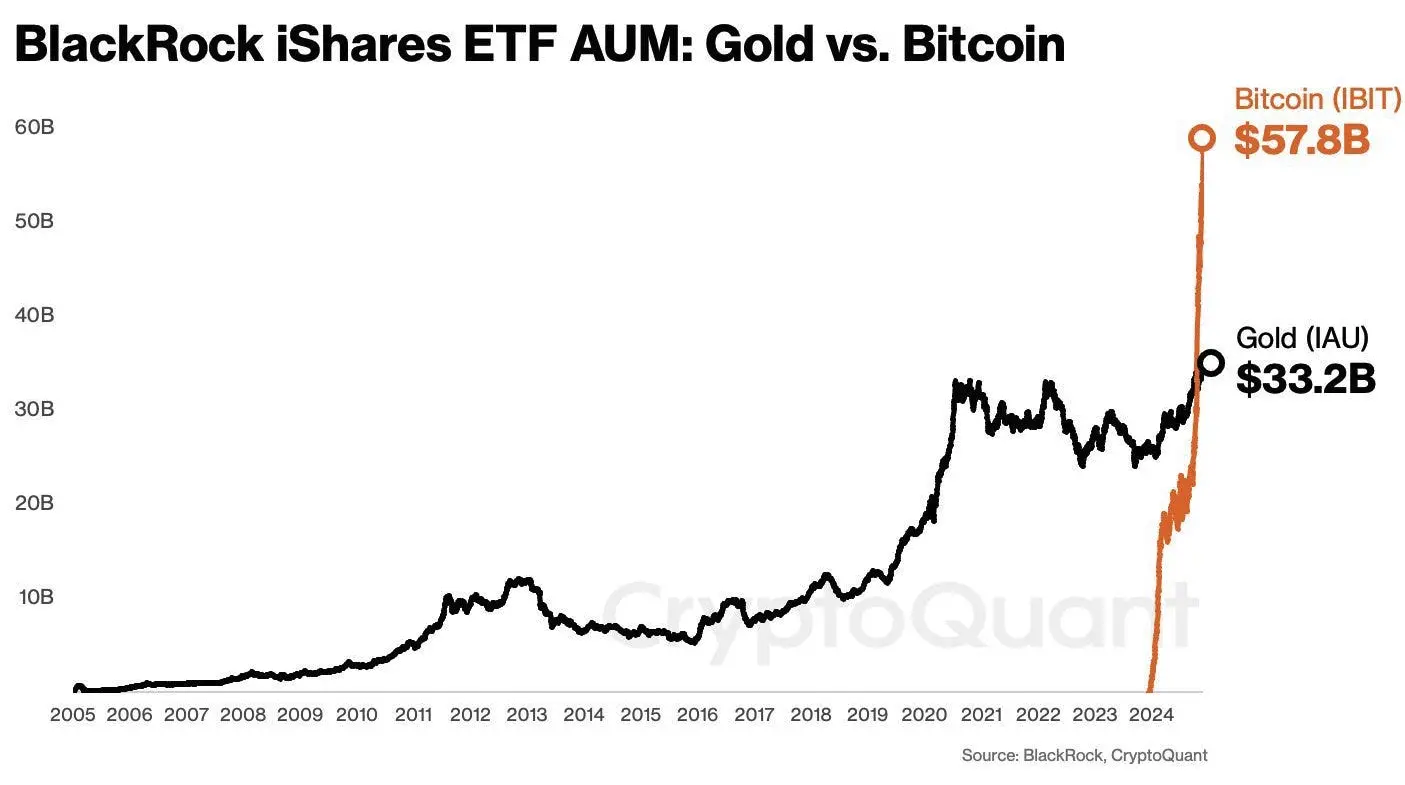
BlackRock's Bitcoin ETF asset management size rapidly surpassed its long-held gold ETF. Source: BlackRock
ETFs have expanded investment channels for blue-chip assets like BTC and ETH, and have also weakened one of Coinbase's key advantages - being the main compliant platform for U.S. crypto investments. Coinbase once had exclusive growth opportunities, which are now being divided by ETF tools, and even directly replaced. More and more new U.S. investors are entering the crypto market through ETFs instead of Coinbase. Although Coinbase will earn custody fees from some ETFs, these revenues are negligible compared to the previous high transaction fees.
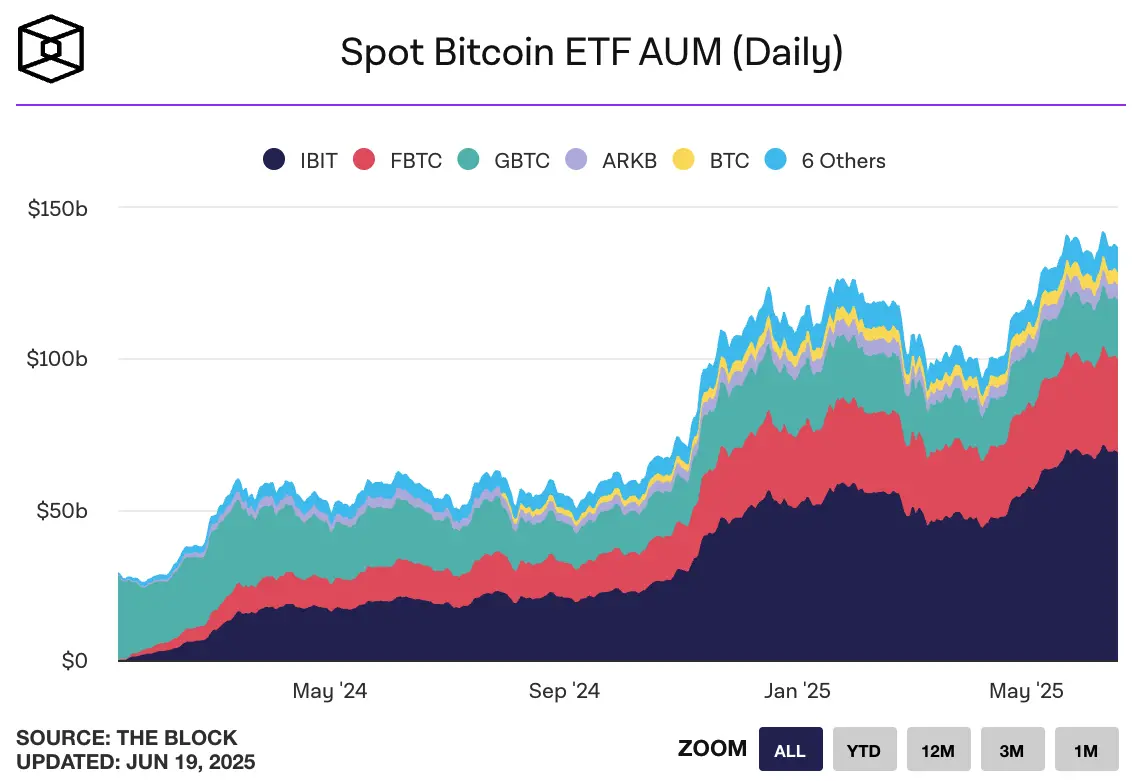
Bitcoin ETF asset management size grows over time. Source: The Block
Missing the Solana Meme Coin Surge
On the other hand, the explosive growth of Meme coins has triggered a new wave of retail speculation. Tools like Pump.fun and Raydium have made token issuance unprecedentedly easy, leading to a nearly 30-fold increase in the number of tokens since the last cycle.
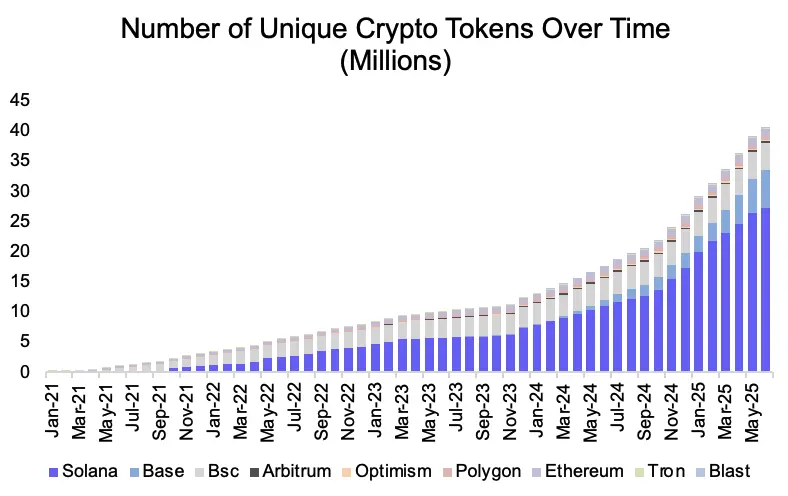
The number of independent crypto tokens increased from less than 1 million in the previous cycle to over 30 million in this cycle. Source: Dune, @cgrogan
Due to strict compliance standards, Coinbase has been slow in listing small tokens or Meme coins. In contrast, the popularity of DEXs has surged, providing instant liquidity for almost all tokens through permissionless and AMM-based mechanisms. This gives DEXs a clear advantage in speed and flexibility, making them the only viable option for users seeking early, high-risk, high-reward opportunities, especially in the Meme coin space.
Coinbase's disadvantage lies in its limited integration with the Solana ecosystem (now the center of Meme coin activity). Therefore, Coinbase has largely missed the Solana Meme coin boom, while DEXs like Raydium and Jupiter have captured the relevant trading volume and user engagement.
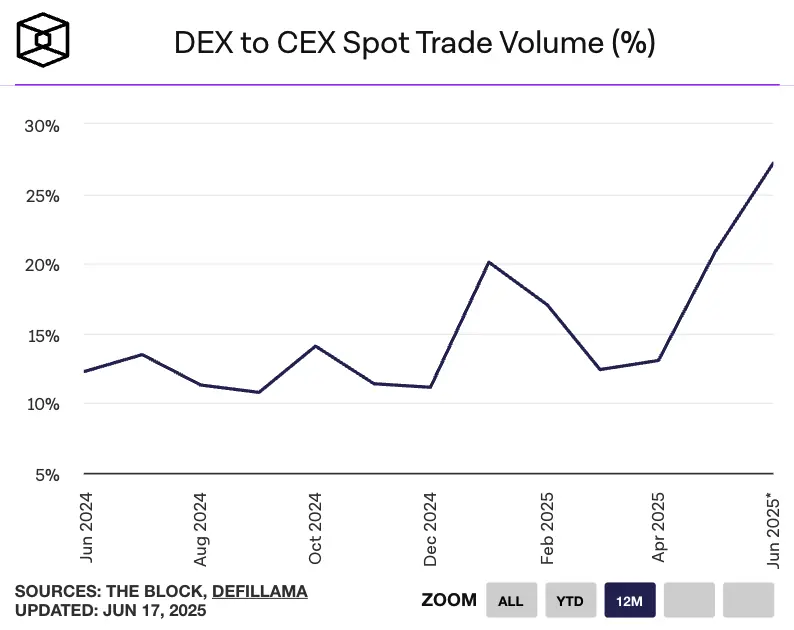
Spot trading volume from DEXs to CEXs doubled in this cycle. Source: The Block
Loss of Compliance Advantage
In addition to the rise of ETFs and Meme coins, the Trump administration has released signals of greater friendliness toward cryptocurrencies, aiming to increase regulatory transparency and end the industry's intense crackdown. For example, Trump's newly appointed SEC chair, Paul Atkins, quickly took action to revoke the strict enforcement measures against platforms like Coinbase and Kraken from the Gary Gensler era.
Therefore, traditional finance platforms with strong retail channels, such as Robinhood, have entered the crypto market. This transformation is evident in the data: by the fourth quarter of 2024, Robinhood's retail revenue accounted for 76% of Coinbase's, highlighting the decline in Coinbase's market share. While clearer regulations are beneficial for the entire crypto industry, they also lower the entry barriers.
Previously, strict compliance policies benefited companies with ample resources like Coinbase, but in the new, more relaxed regulatory environment, small exchanges and traditional finance platforms can compete more effectively.
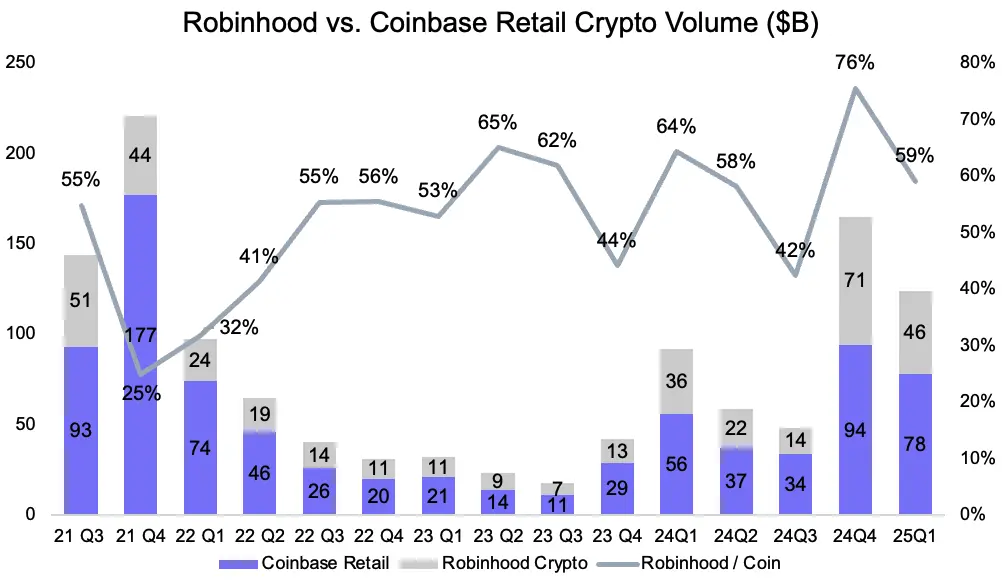
Robinhood's retail trading volume has significantly increased compared to Coinbase. Source: Coinbase Quarterly Reports, Artemis
The intensified competition in the entire cryptocurrency market should put greater pressure on Coinbase, forcing it to lower its high fees, otherwise it will face the risk of losing market share. In fact, Coinbase's share of transaction volume in USD-supported exchanges has already declined - from a peak of 60% to around 50% now, and during the Meme coin boom, it once fell to a low of 32%.
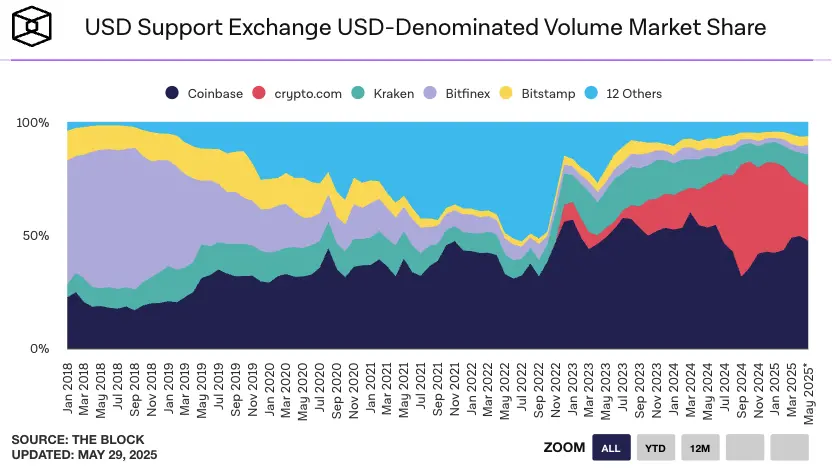
With the launch of ETFs and the rise of Meme coins, Coinbase's market share in USD-supported exchanges has declined. Source: The Block
More importantly, Coinbase's transaction fee rate has also dropped significantly, from a peak of 2.5% to around 1.4%. If it weren't for the recent launch of derivatives, this drop would have been even larger.Notably, after the FTX collapse, Coinbase's fee rate spiked in late 2022, when Coinbase enjoyed near-monopoly status in the U.S. market. This trend peaked in the fourth quarter of 2023, just before the launch of Bitcoin ETFs, marking the beginning of a more competitive and institutional stage in crypto trading.
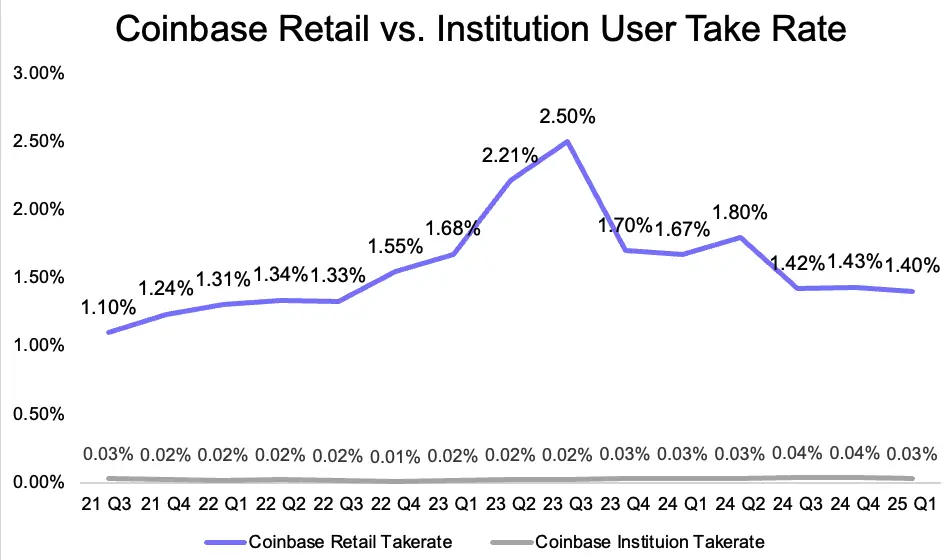
Coinbase's retail fee rate has dropped from a peak of 2.5% to 1.4%. Source: Coinbase Quarterly Reports, Artemis
New Monetization Businesses for Coinbase: Derivatives and Base
The competitive landscape for Coinbase has changed significantly in this cycle. One end of its core business model, "from exchange to on-chain economy," is now under threat. Although Coinbase is currently facing intense competition, there are three monetization businesses that may become its core pillars: derivatives market and Base.
Derivatives Market: No Expected Futures?
Derivatives remain the most profitable segment in crypto trading. In 2024, Coinbase launched a limited range of international derivative products and saw rapid adoption. Coinbase noted that although the first quarter of 2025 showed strong growth in trading volume, derivatives are still in the early stage and could become a key driver for attracting institutional users. However, due to ongoing marketing efforts, the impact of derivatives on revenue so far has been limited, as rebates and liquidity incentives have offset institutional trading income.
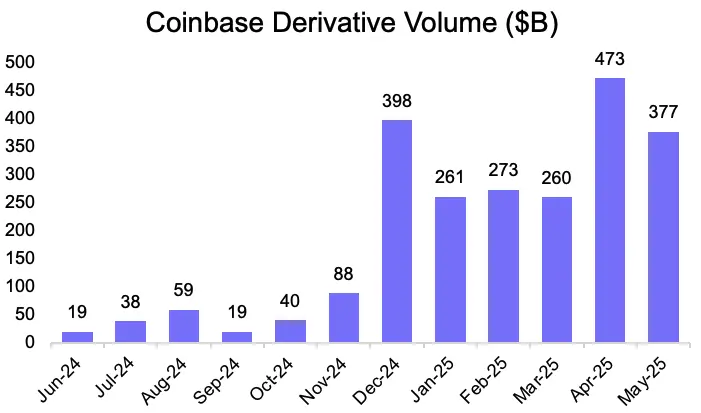
Coinbase derivatives trading volume increased significantly after Trump won the presidential election. Source: Coingecko
In 2024, Coinbase's main goal in launching derivatives was to better monetize existing users and attract new ones. However, apart from a brief surge in Meme season users at the end of 2024, international user growth was minimal. Although derivatives contributed higher trading revenue, they did not significantly drive user growth.
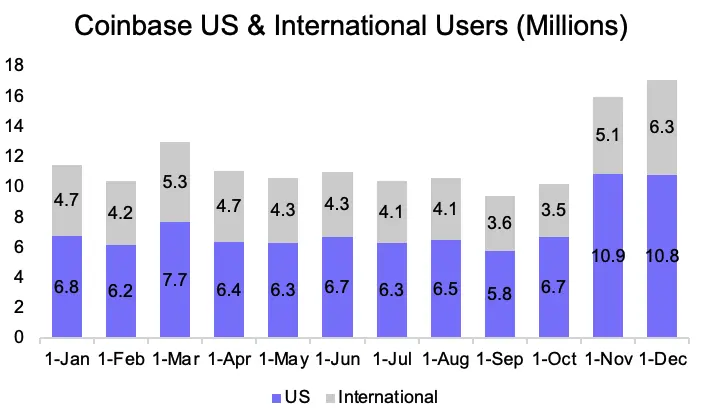
Changes in active users of Coinbase domestically and internationally over time. Source: Data AI
In 2025, Coinbase began offering derivative services to U.S. users to better monetize its domestic user base. However, this launch coincided with the rapid rise of Bitcoin options linked to ETFs. Since most derivatives are concentrated on blue-chip assets like BTC and ETH, Coinbase faces direct competition from ETF options, further limiting its growth potential in this area.
In summary, although the derivatives business has become an important source of revenue for Coinbase in the short term, it still faces challenges in the long run, unless it can break through the limitations and attract new users in an increasingly crowded and fragmented exchange market.
Base: Coinbase's Bet on On-Chain Infrastructure
Base is Coinbase's Ethereum Layer 2 scaling platform, aimed at bringing users into the on-chain economy while diversifying Coinbase's revenue. Unlike other Layer 2 platforms, Base uses ETH as its native currency and has no native token. With Coinbase's brand and support, Base quickly gained popularity due to popular applications like FriendTech and Farcaster, and became the highest transaction volume project on Ethereum Layer 2 within its first year of launch.
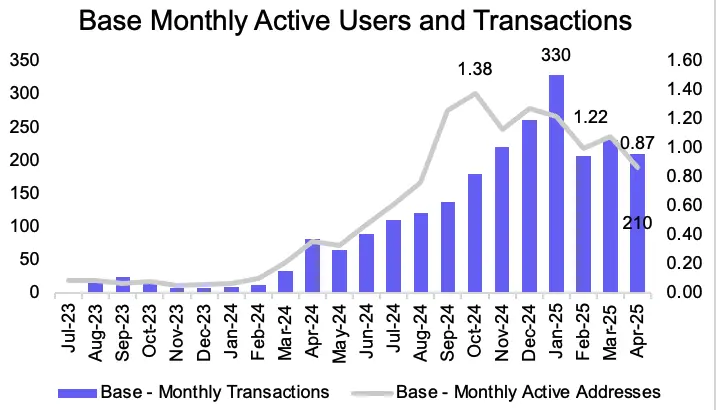
Figure 18: Monthly active addresses and monthly transaction counts for Base. Source: Artemis
Coinbase generated significant revenue by operating the Base sequencer. According to Dune data, Base generates approximately $1 million in gross profit per week, with a profit margin of around 90%. In addition, Base accounts for more than 75% of the total profit of Ethereum Layer 2, demonstrating its efficiency and market dominance. In addition to sequencer fees, Base brings users into Coinbase's ecosystem through its wallet and applications, and creates revenue through cryptocurrency purchases, Swap, and Base-native applications. Base also supports Coinbase's B2B products, such as Cloud, OnchainKit, and SDK. In addition, through collaboration with Optimism, Coinbase is expected to receive up to 118 million OP tokens over the next six years, which will be tied to the growth of Base.
But the core limitation of Base lies in its positioning as a modular Ethereum L2, which leads to fragmentation between liquidity, users, and developers.Asset bridging from Ethereum increases losses, and limited interoperability between L2s hinders seamless integration. These issues stem from differences in blockchain finality, causing cross-chain liquidity transfer to be slow, costly, and complex. Although tools like AggLayer and cross-chain bridges exist, the modular structure still presents challenges.
Therefore, Base is developing rapidly, but its adoption (measured by active users and transaction volume) still lags behind more unified, scalable monolithic chains, such as Solana, whose daily active users are three times those of Base, and daily transaction volume is seven times that of Base.
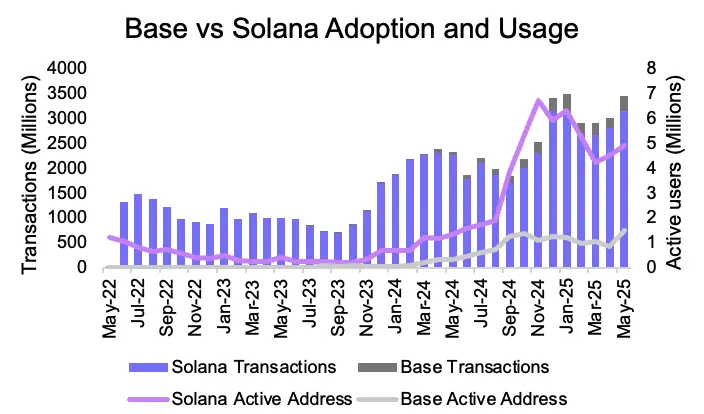
Base vs. Solana's monthly active addresses and monthly transaction volume. Source: Artemis
How Much Is Coinbase Worth?
We will use a classification and aggregation valuation method, breaking it down into the following parts:
Exchange Business: including transaction revenue, subscriptions, and blockchain rewards
Base Revenue: Revenue generated by the Layer 2 network Base of Coinbase
USDC Revenue: Revenue share from Coinbase's collaboration with Circle
Interest Income: Interest income from cash and USDC reserves
Exchange Business Valuation: $80.7 billion
Fundamentally, Coinbase's exchange business is both cyclical and increasingly competitive. To value it, we used the average revenue multiple of traditional brokerages, reflecting a more stable and mature market structure.
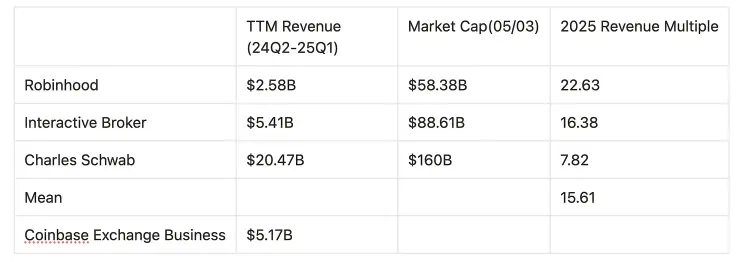
Using this multiple, the valuation of Coinbase's exchange business is: $51.7 billion × 156.1 = $80.7 billion.
<
Disclaimer: Contains third-party opinions, does not constitute financial advice








Alpha Research
Alpha New Token Research Report, Binance Alpha Operation Suggestions
Popular Airdrop Tutorial
Selected potential airdrop opportunities to gain big with small investments
Crypto-linked Stocks
Crypto-stock linkage, real-time market quotes and in-depth analysis
Market Analysis
BTC/ETH, Major Cryptocurrencies, and Hot Altcoins Price Trends
Regulatory Watch
American Crypto Act – timely interpretations of policies worldwide
Frontier Insights
Spotlight on Frontier, trending projects, and breaking events
Crypto Weekly
Tracking on-chain movements of the smart money and institutions

ChainThink App

WeChat Official Account

WeChat Customer Service







